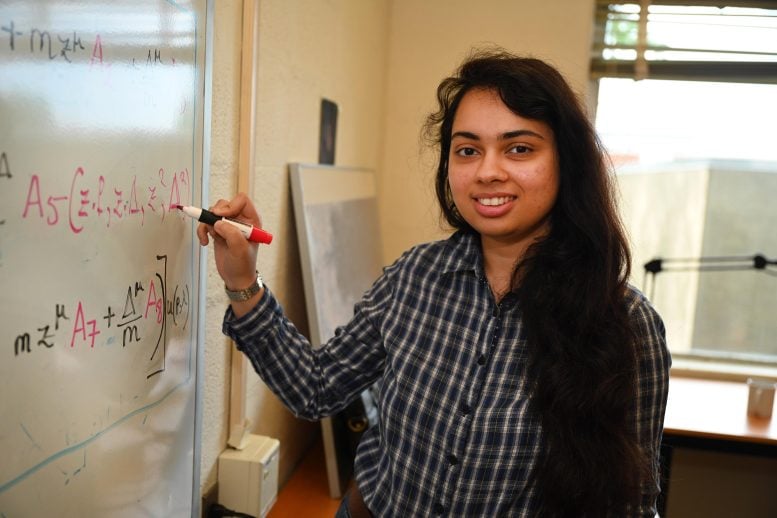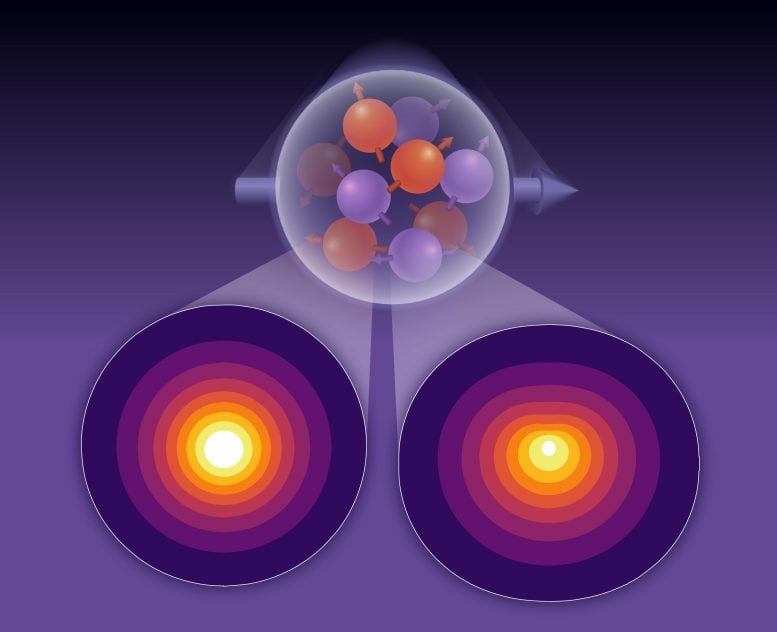The diagram shows a proton moving toward an observer at nearly the speed of light, with its spin aligned horizontally (large arrow). Two views of the bottom concentric circles show the spatial distribution of the up (left) and down (right) quark momentum within this proton (white is high; purple is low).Image source: Brookhaven National Laboratory
Nuclear theorists have developed high-resolution maps of the distribution of quarks within a proton, using advanced computational models to distinguish the roles of up and down quarks in the proton’s properties.
Nuclear theorists from the U.S. Department of Energy (DOE) Brookhaven National Laboratory, Argonne National Laboratory, Temple University, Adam Mickiewicz University in Poland, and the University of Bonn in Germany collaborated to use supercomputers to predict the space of electrical charges. Distribution, momentum, and other properties of the “up” and “down” quarks within the proton.Results published in journal Physical Review Drevealing key differences in the characteristics of up and down quarks.
“This work is the first to use new theoretical methods to obtain high-resolution maps of quarks within a proton,” said Swagato Mukherjee of Brookhaven Laboratory’s Nuclear Theory Group and a co-author of the paper. Author. “Our calculations show that up quarks are more symmetrically distributed and travel smaller distances than down quarks. These differences mean that up and down quarks may make different contributions to the proton’s fundamental properties and structure, including its internal energy and spin. contribute.
“Our calculations provide input for interpreting data from nuclear physics experiments that explore how quarks and the gluons that hold them together are distributed within protons,” said co-author Martha Constantinou of Temple University. This results in the overall properties of the proton.
Such experiments are already being conducted at the Continuous Electron Beam Accelerator Facility (CEBAF), a DOE Office of Science user facility at the Thomas Jefferson National Accelerator Facility. Future plans for Brookhaven Laboratory’s Electron Ion Collider (EIC) will use a higher-resolution version. In these experiments, high-energy electrons emit virtual particles of light that scatter and change the overall momentum of the protons without breaking them apart. The way the proton’s momentum changes with these scatterings reveals details about the quarks and gluons (the internal building blocks of the proton), a bit like X-ray imaging of the building blocks of bulk matter.
New theoretical approaches to GPD
Specifically, scattering allows scientists to understand the generalized Paton distribution (GPD) of protons — Paton is the collective name for quarks and gluons. If you imagine a proton as a bag filled with marbles representing quarks and gluons, GPD describes how the energy momentum and other properties of those marbles are distributed within the bag, such that the marbles bounce when the bag is shaken. Take a walk. It can be compared to a map that indicates the likelihood of finding a marble with a specific energy momentum at a specific location within the bag. Understanding the distribution of these quark and gluon signatures allows scientists to understand the inner workings of protons, which could lead to new ways of applying this knowledge.
“To get a detailed picture, we need to analyze many scattering interactions, including various values of proton momentum changes,” said Shohini Bhattacharya, a researcher in Brookhaven’s Nuclear Theory Group and the RIKEN BNL Research Center (RBRC).

Shohini Bhattacharya, a physicist in Brookhaven Laboratory’s Nuclear Theory Group and the RIKEN BNL Research Center (RBRC), helped develop a new formalism for understanding the distribution of quarks and gluons within a proton. The team used this method to predict the spatial distribution of charge, momentum and other properties of the “up” and “down” quarks within the proton.Image source: Brookhaven National Laboratory
To effectively simulate the proton’s multiple momentum changes, the researchers had to develop a novel theoretical approach, recently published in Physical Review D.
Previously, theorists used the idea that the change in a proton’s momentum is divided equally between the proton before and after light scattering. This simplification provides a less accurate representation of reality and also makes simulations computationally expensive.
“Each value of the proton’s momentum change requires a separate simulation, which significantly increases the computational burden of obtaining a detailed proton map,” explains Bhattacharya.
“The new method can treat the effects of momentum transfer as all effects on the outgoing proton (final state). This provides a view that is closer to the actual physical process,” she said.
“Most importantly, the new theoretical approach makes it possible to model a large number of momentum transfer values in a single simulation.”
Use grid
The calculations that describe quarks and their interactions are elaborated in a theory called quantum chromodynamics (QCD). But because these equations have many variables, they are very difficult to solve. A technique called lattice QCD, originally developed at Brookhaven Laboratory, helps address this challenge.
In this approach, physicists “place” quarks on a discrete 4D spacetime lattice, a 3D grid in which the quarks are located at nodes that explain how the quarks’ arrangement changes over time (pp. four dimensions). The supercomputer solves the QCD equation by going through all possible interactions of each quark with all other quarks, including how these interactions are affected by countless variables.
“A new format for simulating the interaction of photons (light particles) with protons allows us to use lattice QCD to simulate a greater number of momentum transfers, enabling higher resolution imaging approximately 10 times faster than previously possible ,” study co-author Xiang Gao is a researcher at Argonne National Laboratory.
Because the QCD equation has separate variables for up and down quarks, the method allows scientists to capture separate images of each quark type and calculate their respective GPDs.
Results and implications
In addition to mapping the energy-momentum distribution of the up and down quarks, the team also mapped the charge distribution within the proton. They also explored the momentum and charge distribution of quarks in polarized protons, where the proton’s spin is aligned in a specific direction, to study how the internal building blocks contribute to the proton’s spin. Proton spin is a property used daily in magnetic resonance imaging (MRI), allowing doctors to non-invasively observe structures in our bodies. But how this property arises from the proton’s internal building blocks remains a mystery.
“In polarized protons, we found that the distribution of down quark momentum is particularly asymmetric and distorted compared to the up quark,” Gao said. “Since the spatial distribution of momentum tells us about the angular momentum of the quarks inside the proton, these findings suggest that the different contributions of up and down quarks to the proton spin arise from their different spatial distributions,” he noted.
Based on their calculations, the scientists concluded that up and down quarks account for less than 70% of the proton’s total spin. This means that gluons must also make a significant contribution. How the proton’s spin (angular momentum) is distributed among its constituent quarks and gluons provides clues about the proton’s internal structure. This in turn helps scientists understand the forces at work within the nucleus.
Experimental results at Brookhaven Laboratory’s Relativistic Heavy Ion Collider (RHIC), a U.S. Department of Energy Office of Science user facility at Brookhaven Laboratory, support the idea that gluons contribute significantly to spin. This is one of the core issues that will be explored in detail in future EICs.
Joshua Miller, co-author of the doctoral thesis, noted that the new theoretical predictions will be used to provide important information for comparison with these experiments and to help scientists interpret their data. Conducted research at Temple University under the supervision of Constantinou.
“Three complementary things, theory and experiment, have to be combined to get a complete picture of the proton,” Miller said.
refer to:
“Proton GPD moments from nonlocal quark bilinear OPE to NNLO” by Shohini Bhattacharya, Krzysztof Cichy, Martha Constantinou, Xiang Gang, Andreas Metz, Joshua Miller, Swagato Mukherjee, Peter Petreczky, Fernanda Steffens and Yong Zhao, July 17, 2023 Physical Review D.
DOI: 10.1103/PhysRevD.108.014507
“Generalized parton distributions for lattice QCD with asymmetric momentum transfer: non-polarized quarks” by Shohini Bhattacharya, Krzysztof Cichy, Martha Constantinou, Jack Dodson, Xiang Gau, Andreas Metz, Swagato Mukherjee, Aurora Scapellato, Fernanda Steffto and Fernanda Steffens and Yong Zhao, December 26, 2022 Physical Review D.
DOI: 10.1103/PhysRevD.106.114512
This work was supported by the U.S. Department of Energy’s Office of Science (NP) and the National Science Foundation. The computational portion of this work was performed at the facilities of the USQCD Collaboration and the Oak Ridge Leadership Computing Facility, a U.S. Department of Energy Office of Science User Facility at Oak Ridge National Laboratory. Additional funding and computational resources are listed in the scientific paper.
#Peering #proton #supercomputer #reveals #quark #secrets
Image Source : scitechdaily.com
